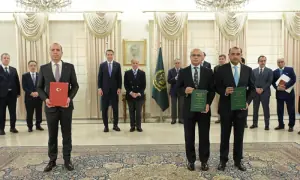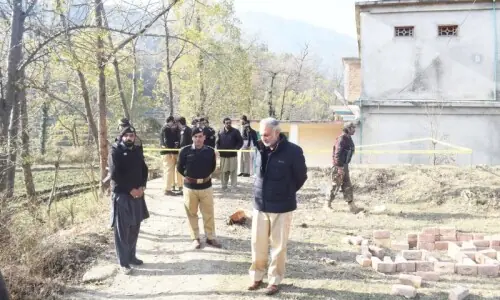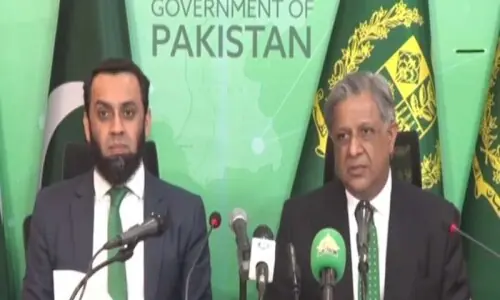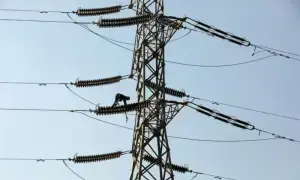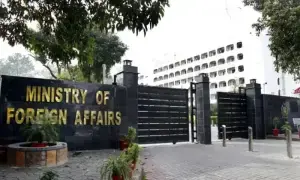
The ongoing debate on the impact of CPEC projects on future external payments’ obligations is welcome, but should be informed by analysis based on facts rather than opinion.
The total committed amount under CPEC of $50 billion is divided into two broad categories: $35bn is allocated for energy projects while $15bn is for infrastructure, Gwadar development, industrial zones and mass transit schemes. The entire portfolio is to be completed by 2030. Therefore, the implementation schedule would determine the payments stream. Energy projects are planned for completion by 2020, but given the usual bureaucratic delays, it won’t be before 2023 that all projects are fully operational. Under the early harvest programme, 10,000 MW would be added to the national grid by 2018. Therefore, the disbursement schedule of energy projects is eight years (2015-2023). Infrastructure projects such as roads, highways, and port and airport development, amounting to $10bn, can reasonably be expected to be concluded by 2025, while the remaining projects worth $ 5bn would spill over into the 2025-30 period.
Examine: Hidden costs of CPEC
Given the above picture, it is possible to prepare a broad estimate of the additional burden on Pakistan’s external payment capacity in the coming years. As the details of each project become available, the aggregate picture can be refined further. The margin of error would not cause significant deviation.
It is possible to prepare an estimate of the additional burden on our external payments’ capacity.
The entire energy portfolio will be executed in the IPP mode —as applied to all private power producers in the country. Foreign investors’ financing comes under foreign direct investment; they are guaranteed a 17pc rate of return in dollar terms on their equity (only the equity portion, and not the entire project cost). The loans would be taken by Chinese companies, mainly from the China Development Bank and China Exim Bank, against their own balance sheets. They would service the debt from their own earnings without any obligation on the part of the Pakistani government.
Import of equipment and services from China for the projects would be shown under the current account, while the corresponding financing item would be FDI brought in by the Chinese under the capital and finance account. Therefore, where the balance of payments is concerned, there will not be any future liabilities for Pakistan.
To the extent that local material and services are used, a portion of free foreign exchange from the FDI inflows would become available. (Project sponsors would get the equivalent in rupees). For example, a highly conservative estimate is that only one-fourth of the total project cost would be spent locally and the country would benefit from an inflow of $9bn over an eight-year period, augmenting the aggregate FDI by more than $1bn annually. This amount can be used to either finance the current account deficit or reduce external borrowing requirements. Inflows for infrastructure projects for local spending would be another $4bn over 15 years.
Taking a highly generous capital structure of 60:40 debt-to-equity ratio for energy projects, the total equity investment would be $14bn. Further, assuming the extreme case that the entire equity would be financed by Chinese companies (although this is not true in the case of Hubco and Engro projects, where equity and loans are being shared by both Pakistani and Chinese partner companies) the 17pc guaranteed return on these projects would entail annual payments of $2.4bn from the current account.
CPEC’s second component, ie infrastructure, is to be financed through government-to-government loans amounting to $15bn. As announced, these loans would be concessional with 2pc interest to be repaid over a 20- to 25-year period. This amount’s debt servicing would be the Pakistan government’s obligation. Debt-servicing payments would rise by $910 million annually on account of CPEC loans (assuming a 20-year tenor). Going by these calculations, we can surmise that the additional burden on the external account should not exceed $3.5bn annually on a staggered basis depending on the project completion schedule.
As a proportion of our total foreign exchange earnings of 2016, this amounts to 7pc. These calculations do not take into account the incremental gains from GDP growth that will rise because of investment in energy and infrastructure. As the loan amounts would be disbursed in the next 15 years and repayments would be staggered, the adding of the entire $15bn to the existing stock of external debt and liabilities is not an accurate representation. The more realistic approach would be a tapered schedule, with $2bn to $3bn getting disbursed in the earlier years and slowing down in the second half.
The question is: how do we find the extra non-debt-creating resources of $3.5bn to offset this additional burden? If the export slowdown was due to energy shortages, the availability of increased supplies should boost exports fetching higher foreign exchange revenues. Exports have to grow by 14pc annually in dollar terms to compensate for these outflows if all other sources remain unchanged. This is not unprecedented as Pakistan has previously recorded this growth rate. Further, the substitution of imported fuels with domestic ones such as hydro, coal, wind and solar should be able to result in savings of at least $1bn annually. These measures will need concerted action.
To make this happen, Pakistan has to take some policy actions on a priority basis: (a) make coordinated efforts to increase the volume of exports by diversifying product mix, penetrating new markets, revising free trade agreements, reducing transaction costs; (b) attract foreign investment in manufacturing and export sectors and set up joint ventures in the industrial zones; (c) channel workers’ remittances though the banking system by reducing the differential between the open and inter-bank market rates; (d) accelerate training of skilled, technical and professional manpower who can take over jobs from the Chinese, thus bringing cost savings and reduced outflows; (e) reform the power sector by privatising DISCOs, mandating Nepra to develop competitive power markets and power exchanges by providing open access to producers for transmission and distribution, setting tariffs through open and transparent bidding, and introducing smart technologies. These measures would certainly help in easing the pressure on external accounts.
The writer is former governor of the State Bank of Pakistan.
Published in Dawn, February 11th, 2017






